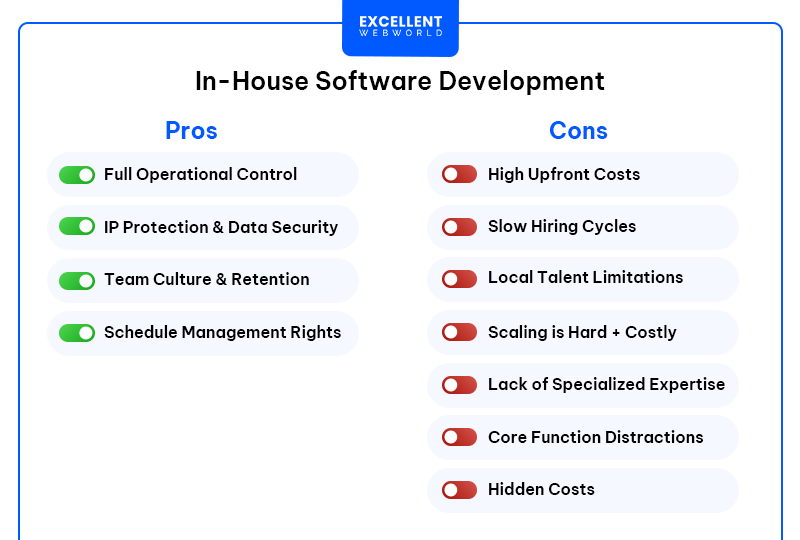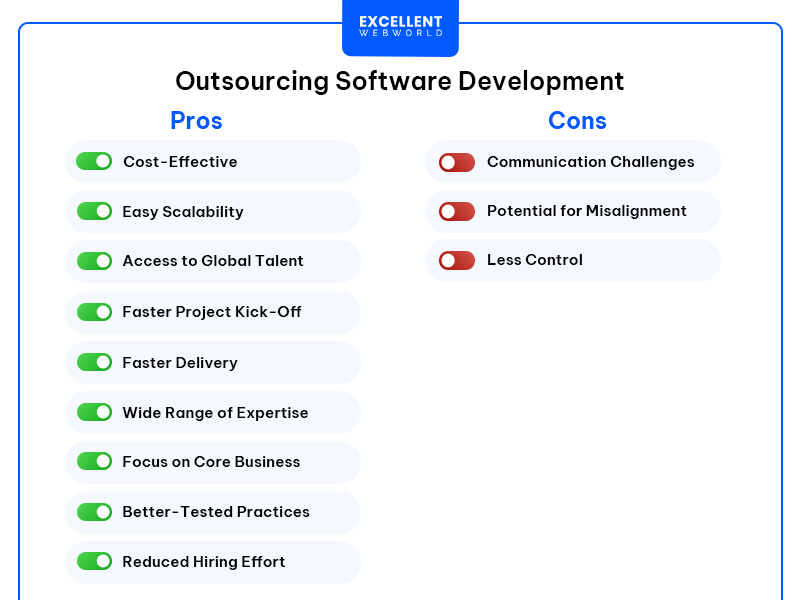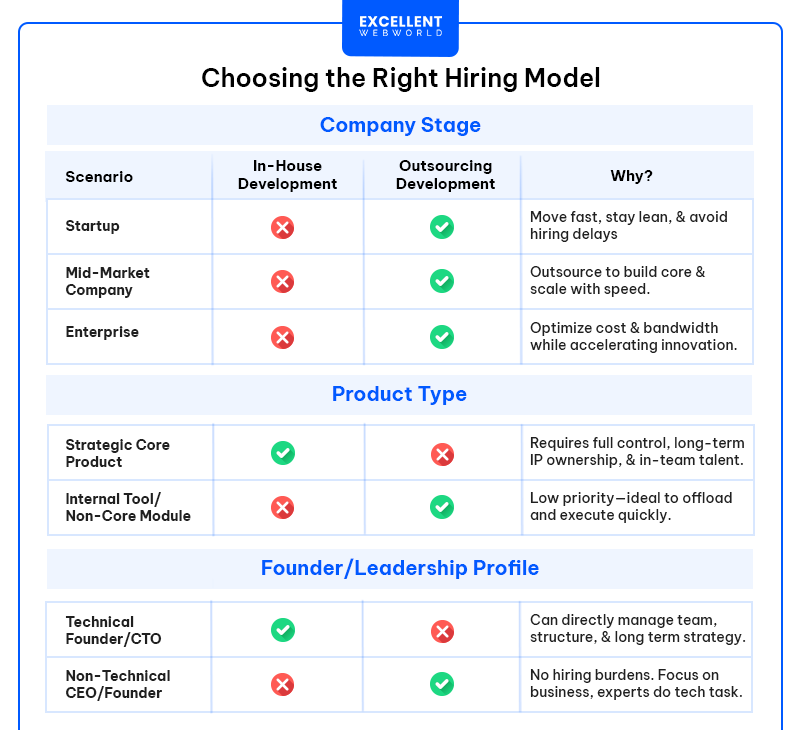One of the most debated topics that creates a dilemma for business owners is the in-house vs. outsourcing debate. And if you are looking forward to choosing one for your next software development project, then this blog will help you weigh the pros & cons of each model based on your product goals, team dynamics, and scaling strategy. Continue reading to explore the advantages and disadvantages of opting for an in-house or outsourcing software development team; it will help you make the right choice.
Choosing between In-house or outsourcing software development? A million-dollar question. Right?
While there’s no one-size-fits-all answer, there are clear factors that can guide your decision. Each method has its own set of pros and cons. Whether you’re scaling a product team, building an MVP, or managing costs while maintaining delivery speed, the right model can make or break your roadmap.
Software development outsourcing is the process of hiring an external team or company from anywhere in the world to execute your work. On the other hand, in-house software development allows you to hire a team for your own premises or assign development tasks to existing employees.
Let’s go deeper into comparing both approaches for software development services so you can make the right decision for your venture.
Why the In-House vs Outsourcing Debate Matters More Than Ever
As companies seek to innovate, scale, and adapt to new trends, the decision between in-house and outsourcing software development is no longer just a matter of budgeting. We are part of an era where digital product growth is on the next level.
From startups to enterprises, everyone, including solo founders with an MVP dream, is under the same relentless pressure: build fast, scale smart, and stay cost-effective. But there is a catch: tech talent is scarce, timelines are short, and user expectations are high. This is where the outsourcing vs. in-house decision becomes a turning point.
In fact, the market is shifting rapidly with new software development trends, and choosing between in-house and outsourcing is even more critical. Generative AI, vibe coding, and the rising popularity of offshore outsourcing are among the factors that can influence your decision on choosing a hiring model.
You are constantly weighing between
These debates are not just limited to the internet and conversations; they can significantly impact your roadmap, team morale, and ultimately, customer satisfaction. That’s why the debate around choosing between in-house development and partnering with a custom software development company is more relevant than ever.
For a deeper dive, you can also explore the benefits of custom software development in our dedicated article.Let’s move on to discussing the insourcing vs outsourcing pros and cons.
The Pros and Cons of In-House Software Development
When it comes to building an app or software, opting for an in-house team is beneficial for companies that prioritize control, collaboration, and long-term alignment. Let’s break down the benefits and drawbacks associated with in-house software development. Therefore, you can understand where this hiring model excels and where it may fall short.
Benefits of In-House Software Development
1. Full Operational Control and Direct Supervision
Having a level of control over your team is one of the significant advantages of hiring an in-house software development team. When you hire dedicated software developers and other IT professionals at your company premises, you are making them part of your culture and processes. For business operations, it brings tighter integration, easy collaboration, and direct supervision of their work.
2. IP Protection & Data Security
If you have your own in-house software development team at your own premises, there’s less risk of IP leaks or data breaches. The network, the resources, and the access, everything stays within your infrastructure and is governed by your company’s compliance protocols.
3. Team Culture & Retention
You can build an internal team that fosters company loyalty and culture. Your team has a clear idea regarding what’s actually going on in your company, what the long-term company vision is, and what you are expecting from them. This in-house development has clear transparency on requirements and expectations. Software developers are more likely to align with your business goals and become invested in the product’s success.
4. Schedule Management Rights
Whether you prefer an in-office work culture or a remote work culture, you can set the same and shared working hours for your whole team. That means in-house software development enables you to make everyone available at the same time. This way, you can enhance the collaboration between designers, developers, and project managers.
Drawbacks of In-House Software Development
1. High Upfront & Ongoing Costs
In-house software development typically requires a substantial financial commitment from the outset. You must bear fixed and recurring costs associated with an in-house team, including developer salaries, as well as a business budget for employee benefits, recruitment expenses, initial training, onboarding programs, hardware and software licenses, and a physical or hybrid office setup.
Making this model sustainable without long-term funding or consistent revenue streams is pretty hard. For early-stage companies or in expanding a new venture, the cost of in-house software development can become a barrier to rapid digital product development and scalability.
2. Slow Hiring Cycles
If you are thinking that finding and hiring top-tier talent is a piece of cake, then you are wrong! It can take several weeks or even months to find, evaluate, interview, finalize, and onboard the right candidates to fit the role. This is especially time-consuming for the high-profile and experienced roles like AI developers, DevOps engineers, cloud architects, or machine learning experts.
As you know, the market is rapidly changing and growing; these delays can be costly, lead to missed product deadlines, slow feature rollouts, and cause delays to go-to-market strategies. Unlike outsourcing, where you get an experienced team after just one discussion, in-house hiring cycles often lag behind the speed of real business needs.
3. Local Talent Limitations
Hiring an in-house team may limit your options to the available talent in your local area. While this may work in tech hubs of the world, for businesses in places where the pool of qualified developers is limited, it can pose serious challenges.
Hiring professionals with expertise in top developer technologies such as Kotlin, Swift, AI/ML, blockchain, or AR/VR is harder and more expensive locally. Ultimately, this geographical limitation can slow down your journey of innovation and lead to compromises in terms of experienced team, product quality, and custom software development velocity.
4. Scaling is Hard & Expensive
Once your cutting-edge digital solutions and services gain traction and you need to scale quickly, an in-house model can become your enemy. It is so clear that hiring, onboarding, and integrating new team members takes time, and most high-growth businesses don’t have the luxury of time.
If your business is not fully on a remote setup, then scaling means increased infrastructure costs, expanded office space, and added layers of team management. At the same time, an outsourcing software development team can be scaled up or down with huge flexibility and speed. Simply, scaling with an in-house team can be complex, expensive, and time-consuming.
5. Lack of Specialized Expertise
You may have a talented in-house software development team, but there will be times when your project requires highly specialized expertise, such as real-time communication protocols, AR/VR functionalities, advanced cybersecurity measures, or complex data pipelines.
Hiring full-time AI-driven software developers and experts in these technologies may not be feasible due to cost, availability, or short-term needs. This results in a skill gap for your project that can stall progress or lower the quality of development. With outsourcing, you can access global talent whenever you need to boost your project in a competitive market.
6. Distraction from Core Business Functions
Building and managing an in-house software development team as well as getting productive work from them is not an easy task; it requires your time, energy, and resources. You have to put extra effort into taking follow-ups and solving tech errors to ensure a smooth software development process. Because of this, your focus on sales, customer relationships, partnerships, and fundraising gets distracted.
7. Hidden Costs
Yes, the true cost of in-house development mostly goes beyond your expectations. Apart from salaries and benefits, you may also face indirect expenses, such as developer turnover, recruitment delays, lengthy onboarding cycles, team management inefficiencies, and the risk of burnout.
Moreover, maintaining employee engagement, providing career growth, and ensuring ongoing training become necessary and demand investment. In reality, these “hidden costs” compound over time and can significantly affect the ROI of your in-house development efforts.
The Pros and Cons of Outsourcing Software Development
As product development becomes faster and more global, outsourcing has grown from being a cost-cutting tactic to a strategic growth enabler. Many business leaders have trusted IT outsourcing to accelerate innovation, mitigate modern business challenges with a modern digital-first approach, and remain agile. Let’s break down the outsourcing pros and cons to help you decide when it’s the right move.
Advantages of Outsourced Software Development
1. Cost-Effective
One of the most liked benefits of outsourcing is the significant cost savings. You don’t have to burden your business with the expenses of hiring, onboarding, office space, equipment, and employee benefits. India, Eastern Europe, and Latin America are popular countries to outsource software development, as they offer experienced and skilled developers at lower hourly rates. This way, companies can develop robust software products without exceeding their budget.
2. Easy Scalability (Up/Down)
Business needs change to grow high. Sometimes, you need new expertise and a new team to launch your cutting-edge software solutions quickly. With outsourcing, you don’t have to worry about anything related to the team; you can scale your team flexibly and on-demand without the long-term commitment or hiring cost and without terminating full-time employees.
3. Access to Global Talent
When you outsource, you have the opportunity to hire talent from around the world. You are not limited to local hiring pools. You get access to a global marketplace of highly skilled developers, designers, tech specialists, and AI experts. That means you can have the right team with the exact match of expertise you need, whether it’s AI/ML, AR/VR, or payment gateway integration.
4. Faster Project Kick-Off
Recruiting for technical roles and setting up resources for starting a project can take weeks or even months. Outsourcing agencies typically have ready-to-deploy resources that are sufficient to launch your software solution within days. This is crucial and beneficial when the market is competitive and you want to beat the competition.
May You Want to Read: Outsource Mobile App Development (Cost + Tips)
5. Faster Delivery
Many outsourcing models include distributed teams across time zones, which allows work to continue even when your local team is offline. This 24/7 development cycle can boost the product delivery speed significantly. Plus, professional and experienced outsourcing partners mostly have optimized workflows, reusable components, and efficient QA pipelines that can give the right outcomes by taking less development time.
Also, outsourcing models such as onshore and nearshore software development give you the benefits of working with a team that doesn’t have language, distance, or time-zone barriers. Ultimately, it improves collaboration and communication, preventing your outsourced team from misleading your business goal.
6. Wide Range of Expertise
Outsourcing vendors mostly have teams with varied software development frameworks and domain expertise. If you want a React Native app, blockchain wallet, or AI-driven software solution, these firms can assign specialized experts as needed. These can save you from hiring multiple developers at a high cost for short-term or niche tasks.
7. Focus on Core Business
It’s so simple that you are sharing the part of your workload; then you can focus more on the other part. That means by offloading the software development workload, you and your internal team can stay focused on what they do best – strategy, customer acquisition, marketing, operations, or fundraising. This way, you can ensure better productivity and your business priorities don’t get diluted in the process.
8. Better-Tested Practices
Established outsourcing software development companies, such as Excellent Webworld, bring experience from working on a wide variety of products and industries. They have already seen what will actually work and what will not, mostly bringing tested and proven practices like agile software development, pre-built libraries, and process efficiencies to the table. This can lead to cleaner code, faster iterations, and fewer bugs to get positive outcomes as fast as possible.
9. Reduced Hiring Effort
Hiring top talent is both challenging and expensive. Outsourcing can remove all the stress of posting jobs, screening resumes, conducting technical interviews, and onboarding. The outsourcing company will manage all the headaches of recruitment, project allocation, and team management. So, you can highly focus on deliverables instead of headcounts.
Disadvantages of Outsourcing Software Development
1. Communication Challenges
When you opt for outsourcing models such as offshore software development, you have to face communication and collaboration challenges. Different time zones, language differences, and varying work cultures in offshore countries can lead to miscommunications if not managed proactively.
This is why many businesses prefer partnering with a nearshore software development company to minimize these communication barriers.
2. Potential for Misalignment
If you lack in delivering your business mission and vision, long-term goals, or expectations clearly, then your outsourcing teams can easily drift off course. You have to be very sure about specifying your project requirements to the outsourced software development team; otherwise, it can waste your money and time.
3. Less Control
Outsourced software developers aren’t sitting with you daily. You may have less visibility into day-to-day progress and decision-making. You can not continuously keep an eye on their work, as their working hours may vary. The control over the outsourced team is less than the in-house team.
Comparative Breakdown: Cost, Speed, Control, and Scalability
When choosing between in-house vs outsource development, entrepreneurs mostly evaluate four key factors in software project estimation: cost, development speed, control, and scalability. The following is a side-by-side comparison to help clarify the strengths and trade-offs of each hiring model for IT development.
| Factor | In-House Development | Outsourcing Development |
|---|---|---|
| Cost | Hiring cost is high with onboarding & salary expenses. | Lower hourly/vendor rates. |
| Employment | Long-term, with the burden of employee benefits & career growth. | Flexible + No long-term employment obligations. |
| Development Speed | Slower ramp-up due to hiring cycles & team building. | Faster project kick-off with ready teams. |
| Control | Full visibility and day-to-day management. | Limited visibility and control over daily operations. |
| Scalability | Scaling is tough as it requires time, budget, and recruitment. | Rapid team scaling up/down based on needs. |
| Talent Access | Restricted to the local hiring pool. | Specialized and diverse talent availability on a global level. |
| Technical Skills | Harder to find a niche or emerging tech skills. | Faster access to tech and domain experts. |
| Long-Term Value | Builds strategic capacity and IP knowledge in-house. | May not build internal IP depth. |
How to Choose Based on Your Company’s Stage, Product Type & Goals
Choosing between in-house vs outsourcing software development isn’t just a budgeting decision, but it’s a strategic alignment question that can vary based on the company size and business goals. The best model depends on where your company actually stands, what you are building, how it is solving the real-life problems, and who is leading the product vision.
This comparison isn’t about which model is better; in fact, it is about which will give you more benefit to your business and become smarter for your context.
So, before rushing into hiring your software development team internally or externally, first, understand your business scenario. It will help you make a confident, risk-aware, and future-proof decision.
Most Commonly Outsourced Software Development Services
Outsourcing isn’t just for end-to-end software development. Many companies outsource various types of specific services based on their needs. Whether it’s to accelerate development, reduce costs, or tap into specialized technological skills. Below is a breakdown of the most in-demand software development services businesses outsource nowadays:
| Service | What It Covers | Why Companies Outsource It | Ideal For |
|---|---|---|---|
| Web Development Services |
|
|
|
| Mobile App Development Services |
|
|
|
| UI/UX Design Services |
|
|
|
| DevOps & Cloud Application Development Services |
|
|
|
| End-to-End Custom Software Development Services |
|
|
|
| AI Development Services |
|
|
|
The Final Answer: Should You Outsource Software Development or Build In-House?
The final answer of opting for in-house vs outsourcing software development depends on the business status and future goals. If you need speed, flexibility, and cost-efficiency, the smarter move is to outsource software development. Mostly, startups and enterprises that are scaling their services will opt for the outsourcing hiring model for software development.
It lets you access top global talent, reduce deployment time-to-market, and stay focused on your core business and marketing goals without the delays and expenses of building an internal team from scratch. Top AI-based software development companies like Excellent Webworld are popular for providing efficient and client-friendly outsourcing services all over the world.
On the other hand, in-house development makes sense when you’re working on a long-term and IP-sensitive digital product with an already strong technical team in place. Ultimately, the decision comes down to your company’s stage, product type, and future visions. Align those, and you will get your answer clearly.

Article By
Mahil Jasani began his career as a developer and progressed to become the COO of Excellent Webworld. He uses his technical experience to tackle any challenge that arises in any department, be it development, management, operations, or finance.






